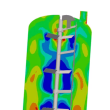Loading...
Project
Universität zu Köln (UzK) - Technical University Freiberg (TUF)
FROSch – Fast and Robust Overlapping Schwarz Domain Decomposition Methods (Nonlinear FROSch (UzK), Multi-Level-FROSch (TUF))
FROSch [36, 87] is a solver software package of the open-source
software library Trilinos [88], which is primarily developed at UzK and TUF in cooperation with
Sandia National Laboratories, USA. In FROSch, we will extend parallel overlapping domain
decomposition methods for fluid problems in terms of scalability towards exascale, improve the use
of GPU accelerators, and make the methods usable for StrömungsRaum®. Starting from already
developed monolithic, overlapping Schwarz methods for linear Stokes and nonlinear Navier-Stokes
equations [32, 33], we will pursue two different strategies to make the user software
StrömungsRaum® exascale-capable. In the first strategy (TUF), we will combine it with the latest
variants of the algebraic 3-level FROSch methods [39]. For such variants of the recently developed
algebraic 3-level FROSch solvers [39], scalability was achieved for up to 220,000 cores of the
Theta supercomputer (Argonne) [40], after scalability for up to almost 100,000 cores of the
SuperMUC-NG supercomputer (LRZ, Munich) had been demonstrated before [40]. Differences in the
performance of Theta compared to SuperMUC-NG in [40] suggest further flexibility of the coarse grid
communication patterns in FROSch, which should occur for the new methods in this project. Due to
the algebraic structure of FROSch, no grid hierarchies are required for the construction of coarse
grid problems on the second and third level, as they are usually required for geometric multigrid
methods. Such difficult grids occur regularly in typical applications of IANUS due to complex
geometries, see example 1 and fig. 1. In the second strategy (UzK), we will combine nonlinear
overlapping Schwarz methods [38] with the monolithic domain decomposition methods for the
Navier-Stokes equations [32, 33]. Nonlinear non-overlapping domain decomposition methods of the
FETI-DP type have already scaled in parallel on the supercomputer Mira (Argonne) on up to 786,432
cores [46] as well as on almost the entire Theta (Argonne) [47]. Based on these experiences, the
approaches from [38] are to be further developed and combined with the methods from [32, 33]. In
the present project, the algorithms thus obtained will be implemented in FROSch. This is expected
to greatly reduce the number of (pseudo-)time steps necessary for convergence of the respective
nonlinear solution procedure. In combination with the nonlinear flow problems, significant parallel
scalability progress towards exascale is expected. By using Kokkos [11], the use of GPU accelerator
hardware by these new linear and nonlinear algorithms is made possible. The current FROSch
implementation [36, 87] will be connected to FEATFLOW and thus to the StrömungsRaum® platform
through an abstract interface. Both the integration of FROSch into Trilinos and the connection to
FEATFLOW, as well as the use by IANUS in StrömungsRaum®, ensure sustainable software development
and availability. The further development of the FROSch framework is also being driven forward in
two DFG-funded research projects: one project in SPP2256 deals with the thermo-chemo-mechanics of
nonlinear materials; the project in SPP2311 deals with pharmaco-mechanical fluid-structure
interaction. However, in both projects the target architecture is not exascale, but parallel
computers of conventional size and architecture are targeted.





